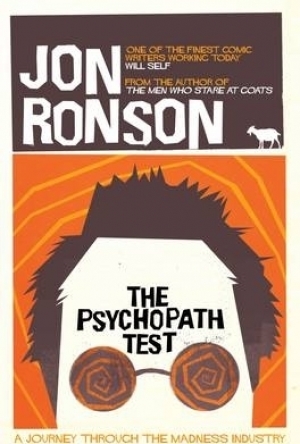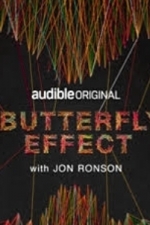Search
Search results
Amber Murray-Schroer (4 KP) rated The Butterfly Effect with Jon Ronson in Podcasts
Aug 17, 2018
Jon Ronson, we want more of you!
Rache (174 KP) rated The Psychopath Test in Books
Dec 10, 2018
Fascinating psychology (1 more)
Dark humour
Humorous Gonzo Journalism
Contains spoilers, click to show
Jon Ronson, the author of Men Who Stare at Goats, dives into the psychology behind the PCL-R, also known as the Bob Hare Psychopath Checklist (revised). Having heard about the checklist, Ronson self diagnoses as a psychopath, and decides to find out more. From talking to high-powered businessmen, to discussing brain scans of psychopaths' brains with an experimental psychologist who has a psychopath's brain scan, this is a fascinating dive into the psychology of psychopathy.
Of course, it wouldn't be a Jon Ronson book if it didn't include Ronson's special brand of gonzo, self-deprecating humour, which ties the whole book together into a cohesive story that will keep you reading "just one more page" until the end.
The only reason I gave this book a rating of 9 and not a 10 is because I have also read Men Who Stare at Goats, which is even better.
Of course, it wouldn't be a Jon Ronson book if it didn't include Ronson's special brand of gonzo, self-deprecating humour, which ties the whole book together into a cohesive story that will keep you reading "just one more page" until the end.
The only reason I gave this book a rating of 9 and not a 10 is because I have also read Men Who Stare at Goats, which is even better.
Suswatibasu (1703 KP) rated The Butterfly Effect in Books
Oct 10, 2017 (Updated Oct 10, 2017)
Well produced but still completely missing a lot
It's pretty incredible to create a series about the effects of mass porn without mentioning how it actually affects the women in it and around it. Once again we have a very male take on women as a mass commodity, narrowing them down to keywords instead focusing on how the men who make it and are responsible for the consumerism are affected. I thought Jon Ronson would explore this issue, but he skirts around it as an aside. Not his best by far.
BookblogbyCari (345 KP) rated The Psychopath Test in Books
Sep 11, 2018
This book is remarkably entertaining – I can see why it’s having such a long stint in the bookseller’s shelves! It’s most definitely written for the lay person, and that goes some way to explaining the book’s longevity.
It logs the course of events taken by Jon Ronson as he interviews some people who are deemed crazy, or psychopathic, and some people who diagnose psychological traits. The start of Ronson’s journey is intriguing - it begins when various academics, predominately neuroscientists, are sent mysterious and cryptic packages. They all rush onto online forums trying to figure out what it’s all about. Unfortunately, this section comes to an abrupt and disappointing conclusion (no spoilers).
This all changes in Chapter 2, however. Here, Ronson meets a man, Tony, who claims to have faked mental illness in order to get put into a psychiatric facility rather than a traditional prison. The Scientologists are on his side, and they send Ronson Broadmoor’s file on Tony, but with significant omissions, which shed a whole new light on why Tony should be incarcerated.
Chapter 3 describes how in the 1960’s psychiatrist Elliot Barker, held several nude LSD-induced psychotherapy sessions for psychopaths. In Chapter 4, Ronson goes on a conference to learn about Bob Hare’s psychopath checklist, and by Chapter 5, he’s using it in an interview with a leader of a death squad, Toto Constant. In Chapter 6, he uses it in an interview with Al Dunlan, who apparently enjoyed firing 6.000 people from their jobs.
Following a brief interlude to discuss the media, conspiracy theorists and the second coming, the theme of psychopathy is picked up again in Chapter 9 which looks at criminal profiling, and how it was once used to lure one particular suspect into an unwarranted arrest.
Ronson goes off on another tangent in Chapter 10, which discusses the (very real) problem of an apparent ballooning of mental illness diagnoses. Here he tells the tale of what happened when a 4-year-old girl was given 10 pills a day for “childhood bipolar” disorder.
In Ronson’s concluding chapter, he attends a tribunal for the Tony of Chapter 2, and Tony’s fate is decided (no spoilers). By this point, Tony’s charisma has got Ronson taken in, in spite of Tony showing several psychopathic traits.
My take away from the book is that people will have eccentricities, diagnosis or not, and the way to tell if someone is dangerous, is by their actions. Ronson himself has spotted psychopathic traits in himself, despite being overly anxious and not the slightest bit evil. The book sheds a lot of light, not only on the nature of obtaining a diagnosis, but also on its implications.
Whilst I do recommend the book, this book is most definitely not a thorough analysis of the mental health industry, nor the criminal profiling industry. But for entertainment purposes it gets top marks. If you are looking for a more authoritative book on the mental health industry and diagnosis, I recommend Saving Normal by Allen Frances.
It logs the course of events taken by Jon Ronson as he interviews some people who are deemed crazy, or psychopathic, and some people who diagnose psychological traits. The start of Ronson’s journey is intriguing - it begins when various academics, predominately neuroscientists, are sent mysterious and cryptic packages. They all rush onto online forums trying to figure out what it’s all about. Unfortunately, this section comes to an abrupt and disappointing conclusion (no spoilers).
This all changes in Chapter 2, however. Here, Ronson meets a man, Tony, who claims to have faked mental illness in order to get put into a psychiatric facility rather than a traditional prison. The Scientologists are on his side, and they send Ronson Broadmoor’s file on Tony, but with significant omissions, which shed a whole new light on why Tony should be incarcerated.
Chapter 3 describes how in the 1960’s psychiatrist Elliot Barker, held several nude LSD-induced psychotherapy sessions for psychopaths. In Chapter 4, Ronson goes on a conference to learn about Bob Hare’s psychopath checklist, and by Chapter 5, he’s using it in an interview with a leader of a death squad, Toto Constant. In Chapter 6, he uses it in an interview with Al Dunlan, who apparently enjoyed firing 6.000 people from their jobs.
Following a brief interlude to discuss the media, conspiracy theorists and the second coming, the theme of psychopathy is picked up again in Chapter 9 which looks at criminal profiling, and how it was once used to lure one particular suspect into an unwarranted arrest.
Ronson goes off on another tangent in Chapter 10, which discusses the (very real) problem of an apparent ballooning of mental illness diagnoses. Here he tells the tale of what happened when a 4-year-old girl was given 10 pills a day for “childhood bipolar” disorder.
In Ronson’s concluding chapter, he attends a tribunal for the Tony of Chapter 2, and Tony’s fate is decided (no spoilers). By this point, Tony’s charisma has got Ronson taken in, in spite of Tony showing several psychopathic traits.
My take away from the book is that people will have eccentricities, diagnosis or not, and the way to tell if someone is dangerous, is by their actions. Ronson himself has spotted psychopathic traits in himself, despite being overly anxious and not the slightest bit evil. The book sheds a lot of light, not only on the nature of obtaining a diagnosis, but also on its implications.
Whilst I do recommend the book, this book is most definitely not a thorough analysis of the mental health industry, nor the criminal profiling industry. But for entertainment purposes it gets top marks. If you are looking for a more authoritative book on the mental health industry and diagnosis, I recommend Saving Normal by Allen Frances.


